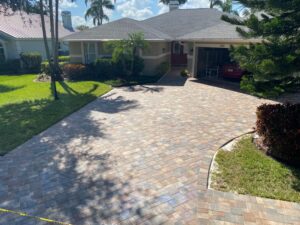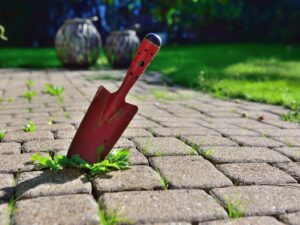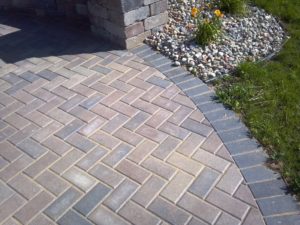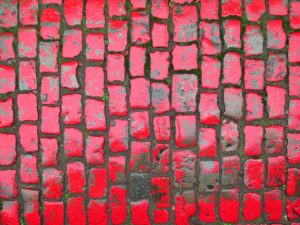Paver installations are a complex thing. There are a lot of variables and details that need to be accounted for, both during planning and execution. One of these detail, and an important one at that if you’re using it, is the correct placement of your edging pavers. So, how to install edging pavers in the most efficient way possible?
The purpose of the edging is to secure your installation in place or to delimitate a specific area, mainly for aesthetic purposes. It can be thought of as a “small wall” in which your pavers will be supported on.
Even if you decide to use regular pavers as “edgings”, maybe in a different design to create a visual style, they’re still going to be considered edging paver for the purposes of that installation specifically. Basically, the edging pavers will end up being just another type of paver in the installation.

Installing Edging Pavers
Everything begins during the planning phase of your paver patio. It is up to you if you want to use different pavers as “edging”, but that would be purely for esthetical purposes since, as we mentioned, what actually secures the pavers in the place are the edgings themselves.
So these pavers need to be included in your installation beforehand. If you are thinking about edgings, it means you already have some idea on how to install pavers. In the off chance that’s not the case, this article can help you with your installation.
A paver installation will usually be one of two ways: the pavers can either be at ground level or above it. The way you install the edging pavers will be different for each type of installation, with each one having its own type of edge.
Ground Level Installation
If your pavers are at the ground level, you’re going to have to dig a hole deep enough to fit your entire edging paver. The depth of this trench must be equal to, at least, the height of your edging paver plus 2 inches of sand.
The amount of paver that will stay “outside” the ground is entirely up to you. If you want it to stay at ground level, the trench must follow exactly the paver height + 2 inches rule. If you want it slightly above, all you have to do is subtract that value to dig a shallower trench.
You also have the option to use lawn edges to secure the edging paver in place after they are set. To account for that space, you can add 1 inch to the sides of your trench so you have space to hammer the lawn edges to the ground later.
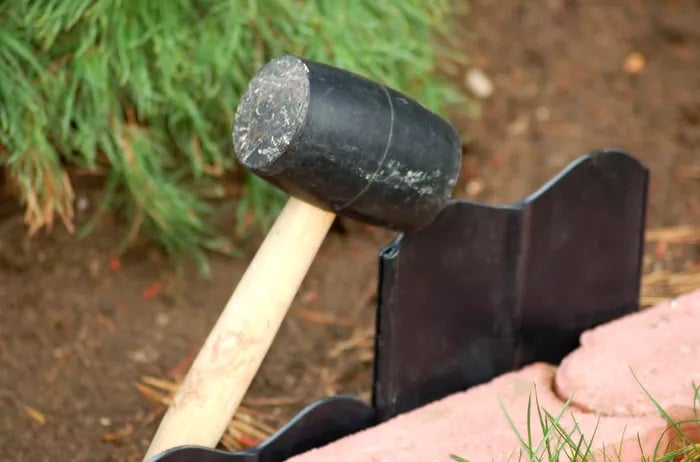
Above Ground Installation
In an above ground installation, it all comes down to the height your overall paver installation will have. But basically, it all follows the same principle as before, except you’re probably going to need higher edging pavers.
Let’s say you want your installation to be about 5 inches above the ground. Your edging pavers will have to be at least that high as well. However, all the pavers will be on the same installation, in a way, so that requires a bit more calculation.
A very common practice is to dig for your installation as normally, but calculate the height of the edging pavers and dig accordingly at the borders of the installation, then you proceed to first put the edging pavers, and then keep up the installation as normally.
Other Types of Edgings
Edgings are important, you can never perform an installation without them.
Like we previously mentioned, by “edging” we mean anything that can be firmly attached to the ground outside the perimeter of your installation, so the pavers don’t move inside.
In installations over concrete, for example, a simple row of pavers set over mortar can do the job. Sometimes pavers will be installed next to a wall, which can also be used as edging. Some forms of landscaping edging can also be used, depending on the load of your paver installations.
Another popular form of edging pavers is what is to use poured concrete to create a toe around your installation. This method is simple, but ineffective as, in time, the concrete will eventually crack. What is done to countermeasure that is to apply fibers in the mixture, but still it is not as reliable as the other methods.
Professional Help With Edging Installation
There are several factors to consider and alternatives to go when adding an edge to your installation. Each paver installation is unique, with its own characteristics and challenges. The best way to make sure you’ll end up with a installation well done, is to hire professionals to help you.
Professionals in the hardscape business have literally seen almost anything there is to see when it comes to paver installation, so they are more than ready to use all that experience to your favor and help you have the best possible paver installation. One that will not cause you headaches in the future.
And if you happen to be around the Sarasota and Manatee Counties, in FL, we here at S&S Paver would be happy to help you with any paver need you might have. For over 10 years we have been serving our community with high satisfaction rate.
Give us a call anytime at 941-773-3098 or, if you prefer, reach us on our email at sales@sspavers.com.

